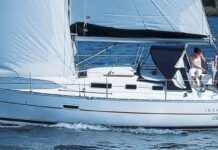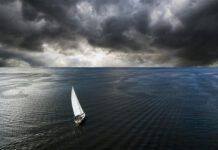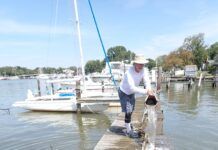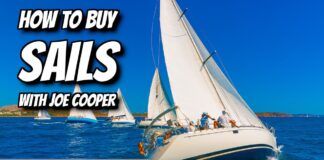
Given the grief that poor centerboard designs from the 1970s have caused sailers over the years, we were surprised to learn that J/Boats-known for its measured approach to the boat business (don’t let that radical backslash fool you)-put a centerboard in its new J/95.
Yes, swing-keel centerboards, those bronze, steel, or fiberglass foils that hinge from the keel like the blade on a Swiss army knife, are making a comeback. This is great news for shoalwater sailers who, for lack of other options, have tolerated decades-old centerboarders and the many ailments that plague them-corroded lifting cables, pulverized turning sheaves, and a thunk, thunk, thunk in the centerboard trunk. Fortunately for them, advances in materials and design have yielded a whole new breed of centerboarder. The J/95, it is safe to say, is not your fathers Irwin 38.
The last time centerboards were all the rage, through the 1950s and into the 1960s, it was because Northeast sailors didnt want to leave their good crystal at home when they raced off to Bermuda. In the Cruising Club of Americas (CCA) quest for a rating rule that favored velvet and walnut interiors, centerboarders gained a significant edge, and few boats took advantage of rule loopholes as well as the legendary Sparkman & Stephens-designed Finisterre. The boat achieved myth-like status in 1960, when owner and skipper Carleton Mitchell won the Newport to Bermuda race for an unprecedented third consecutive time.
When Mitchell died in 2007 at the age of 96, he was rightly hailed as a sailing legend. A one-time underwear salesman who married into a fortune, he served as a Navy combat photographer in World War II before pursuing in earnest a lifelong passion for sailing. In the decades after the war, he earned renown not only for his seamanship but also for his talent as a magazine writer, author, and photographer. The museum at Mystic Seaport in Connecticut holds his large collection of manuscripts and more than 20,000 of his photographs.
Today, Mitchell and Finisterre stand as icons from a golden era, doomed to an eternal afterlife in new boat marketing literature. But when J/Boats alluded to Carleton Mitchell and Finisterre in brochures for the J/95, we wanted a bottle of whatever theyre putting in the company watercooler. Except for a hinged keel and an inclination to float, the two boats are as alike as Neil Simons Felix and Oscar.
Introduced last year, the balsa-core J/95 is a lightweight, 30-foot daysailer with a plumb bow, twin-rudders, a sleek hull form, and a Spartan interior. Launched in 1954, 38-foot Finisterre is a double-planked heavy displacement racer-cruiser with a spoon bow, yawl rig, and almost swanky accommodations (the last three are all convenient CCA rule-beaters).
The reference to Finisterre is smart promotional shtick. The name offers J/Boats-and it is hardly the only company that has drafted on Finisterres fame-an instant connection to the sailors it seeks to entice with the J/95.
Like Morris, Sabre, Friendship, and the other makers of high-end trophy daysailers we reviewed in the January 2009 issue, the J/95 is aimed at recession-proof sailors who share Mitchells aesthetic tastes and passion for sailing. But unlike previous entries in this market, the J/95 sails in four feet of water and offers, in many ways, a saner approach to what dealers are calling “right-sizing.” (No salesman worth his salt would utter the more accurate word, “downsizing,” to a potential buyer of these boats.)
End of an era
The J/95 is the brainchild of Rod Johnstone, a man whose fairy-tale success is well known to longtime PS readers. Back in 1976, Johnstone built a fast little boat called Ragtime in his garage in Connecticut. It promptly trounced the local racers, who started asking Johnstone for their own.
At the time, Johnstone was an ad salesman for Soundings magazine and turned to his client Everett Pearson of TPI Inc. to produce the boat as the J/24. (The J is for Johnstone, the slash, were convinced, is meant to torment copy editors.) J/24s started rolling off the production line at TPI in February 1977. Bob Johnstone, the family marketing ace, left AMF Alcort (makers of the Sunfish) to join Rod as a partner, and crank up the boat sales to unprecedented numbers. Still in production, the J/24 remains one of the most popular sailboats in the world.
Design
The mission for the J/95 is one of those hyphen-rich, have-your-cake-and-eat-it-too quests. Rod Johnstone wanted a wind-in-your-hair, but easy-to-sail weekender that catered to the huge population of sailors who must contend with depths of four feet our less. Being competitive in club or Performance Handicap Racing Fleet (PHRF), and, of course, a fantastically popular one-design class were also part of the dream.
“We wanted to make this a boat people would want sail, sail right up the river or creek, right up to their dock, sail in light winds, sail in 20 knots,” says Johnstone. “In my view, if you want to turn on the engine, this boat is a failure.”
When held up against the current crop of J/Boats, the J/95 is probably closest to the J/105, a popular one-design class boat launched in 1992. Both boats have similar deck layouts, and both feature a low cabintop and gentle sheer that give them good-looking profiles.
Although the J/105s deeper fin keel gives it a performance edge, Johnstone says that in brisk conditions, the J/95, with 2,250 pounds of lead ballast, can stay with the J/105 in a heavy-weather beat. Johnstones explanation for this sheds some light on why many CCA-rule boats remain popular as cruisers.
While the long bulb keel that is the norm in todays racing boats offers superior lift, it can create a pendulum-like pitch and roll and in a seaway. The J/95, with the center of ballast closer to the flotation plane, resists this tendency, making for a more efficient-and more comfortable-ride.
Of course, any of the J/95s gains during a rough beat are soon relinquished to the J/105s longer waterline on a downwind leg, but the point is made.
Compared to contemporary production shoal-draft boats, the J/95 has a key design advantage: twin rudders angled outward at 15 degrees. This means at least one rudder is always immersed, giving the boat predictable tracking, even when heeled. As pointed out in our February 2009 report on hull design, trying to steer the beamy Open Class-inspired hulls with a single shallow rudder can be maddening. In the most extreme cases, a modest puff of 16 knots sends the boat rounding up sharply to windward.
The price for the J/95s shallower draft is ultimate stability. According to J/Boats, the boat has a limit of positive stability of 126, well within the minimum of 120 recommended for offshore racing and fine for daysailing. The 200-pound centerboard doesn’t lock down, but should the board kick up in a grounding or crash downward a 160-degree capsize, it will connect with the soft lead keel and cause no harm to the hull. J/Boats said such an event would not damage the hull. (With our insurance premiums being what the are, we did not test this feature.)
Deck Layout
J/Boats has had plenty of practice pondering deck layouts on race boats, and those same details translate well to any good daysailer. As Johnstone points out, the features that bring efficiency on the race course-broad sidedecks, ergonomic cockpit layout, plenty of mechanical advantage-are equally kind to a titanium knees and hips.
“It just makes me sad to see people I know-friends, no less!-going out and getting power boats because they feel that they can’t sail anymore,” Johnstone grumbles. “And then they realize, too late sometimes, that they have to put up with all that noise.”
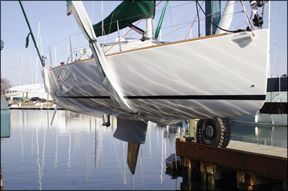
During the design phase, there was some discussion over tiller versus wheel. J/purists might clamor for a tiller, especially those bent on racing, but at what price? Cockpit space would suffer. Comfort and convenience, too.
The 44-inch Edson wheel fits nicely into the wide T-shaped aft section. Two angled chocks provide footing on a heel, and we found the windward rail to be a comfortable spot on a close reach. The transom is open, and the boat we sailed had an optional removable transom-seat locker. Even with the seat-locker in place, theres room behind the wheel.
The cockpit seats arent long enough for snoozing, and an extra inch of back support would be nice, but all in all, the cockpit caters well to crew comfort under way. The seats inside edges are angled upward slightly to anchor the tush, and the seat lockers offer ample space for sail and gear storage. The broad flat coaming is as comfortable a perch as the cockpit seats themselves. Owners can opt for either a full length toerail or one that ends forward of the cockpit. Teak is an option, but one of the appeals of the boat is its ease of maintenance.
The Harken sail controls are geared for minimal effort. The mainsheet (5:1-ratio with a 10:1-ratio fine-tuning adjustment), rides in front of the steering binnacle on an easily-trimmed traveler (4:1-ratio). A Hall Spars Quick Vang (5:1 ratio) handles boom tension.
The jibsheets lead to two 40.2STA two-speed self-tailing winches. The helmsman can easily trim the mainsheet from the windward rail, while the jib sheet winches are placed so that the trimmer can comfortably face forward. Casually seated on the coaming just in front of the wheel, the single-hander can tweak both the main and jib sheets.
The standard working jib is a roller-furling 105 that tacks easily through the foretriangle and leads to a jib track inside the shrouds. We kept the leads pinned just aft of the shrouds during the test sail and saw no need to change them. For PHRF racing, a second track is installed to handle the 150 genoa. (The boats PHRF rating is about 109.)
A Harken 32.2 two-speed self-tailing winch and a gang of three Spinlock rope clutches on the port side of the companionway tame the halyards and the centerboard. We didnt need the winch (or anti-inflammatories) to raise the centerboard, as the 5:1-ratio block and tackle gave plenty of mechanical advantage.
Passage fore and aft is wide and clear of obstructions, with stainless-steel handrails on the coachroof adding security. Eight-inch stainless steel cleats and a modest anchor locker round out the very functional deck layout.
Interior and Systems
With the J/95s emphasis on nice lines and a functional deck layout, its no surprise that the accommodations get the short shrift. Though its billed as a weekender, we call it a daysailer.
For boat camping, the layout takes care of the bare essentials. Two settee berths in the main cabin offer room to recline, but headroom, even when sitting, is tight. A Raritan head (served by a 14-gallon holding tank) shares space with a V-berth forward. A forward hatch and two ports keep the cabin aired out.
There is no nav station or galley, not even a stove, although hull No. 1 was equipped with AC shorepower and a microwave oven. A 48-quart cooler or a portable 12-volt Waeco fridge (PS, May 2007) tucks aft of the port settee. An optional Group 27 house battery will keep the fridge running for a long day without charging.
Optional water tankage is in a 20-gallon bladder that feeds a pressure pump in the head and a cockpit shower. Fuel is in a 15-gallon tank beneath the port cockpit locker. PS generally prefers aluminum tanks for this purpose, but for a tank this small, a baffled polyethylene tank is a tolerable substitute.
The two-cylinder 14-horsepower Yanmar with a saildrive and Flex-O-Fold prop sits beneath slide-out companionway steps. Access is good except for servicing the water and primary fuel filters, when you need to make an awkward reach through a bulkhead cutout. J/Boats says it has worked closely with Yanmar to insure that the saildrive is protected from any galvanic corrosion. Regardless, engine zincs bear watching.
Now for the downers: Like some other Open Class imitators (Beneteau First 10R comes to mind), J/Boats hasn’t yet sorted out how to drain the boats shallow bilge without a sponge. The narrowest electric pump doesn’t fit into the tight squeeze in the sump. It sits on a riser pad, which means the last three inches of water make for an inviting frog pond.
To complicate matters, the hose on our test boats manual pump wheezed at a leaky hose union, rendering the pump useless. A leaky union-or any union at all-in an emergency bilge hose is not the sort of thing wed expect from J/Boats. (The local J/Boat dealer assured us this problem would be fixed immediately.)
We also took issue with the bilges drainage system. A single limber hole less than 3/4-inch in diameter separates the back section of the hull from the main bilge sump. Should a cockpit locker open in a knockdown and seawater flood the aft compartment, most of the water wouldnt reach the pumps until it flowed through that thimble-sized limber hole. In our view, the boat should either have freer flowing limber holes or a pump to serve each large compartment.
Finally, J/Boats was asleep at the wheel when they addressed the emergency tiller on our test boat. There was no dedicated place to stow the tiller, and the deck key used to install it was found in the cabin below, instead of with the tiller. Installed, the rudder worked fine, much better than others weve ranted about.
Performance
We test sailed hull No. 10 in the Gulf of Mexico off of Naples, Fla. The boat was equipped with racing cut Doyle Technora sails: a partially battened mainsail and a roller-furling 105 genoa. A 680-square-foot asymmetrical spinnaker can fly from the retractable bowsprit, but with squalls to the east and just two people on board, this spinnaker stayed in the forepeak.
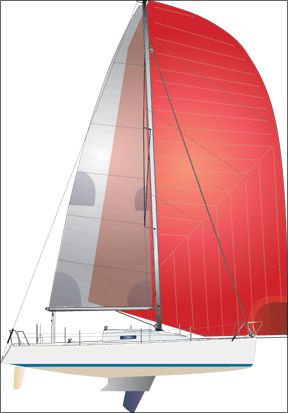
True wind was from the east at 6-8 knots with gusts to about 17 knots when the rain came. Seas were 1-2 feet.
Under power at 2,800 RPM, the boat averaged 6 knots and at 3,250 RPM 7 knots. At wide open throttle in flat water, it held 7.4 knots. Handling under power with the twin rudders was excellent. With the centerboard up or down, the J/95 easily spun in its own length. Not only is this an advantage when docking, but should a crew member fall overboard, a well-drilled crew should be able to execute a near-perfect Quick Stop maneuver (see January 2010 issue).
On a close reach in about 8 knots of breeze, the boat averaged 5.3 knots and tacked through 92 degrees, including any leeway, with the board up. With the board down in about 12-14 knots of breeze, the boat averaged 6.3 knots and gained about 2 degrees to windward on each tack.
J/Boats advertises upwind speeds of 6.5 knots and tacking angles of less than 90 degrees with the board up, and angles better than 85 degrees with the board down. Based on the test boats performance, this is well within reach of a well-sailed, well-tuned boat. The fastest average speed under sail came when a squall brought about 15 knots of wind on the beam. With the true wind at 120 degrees, the boat marched off at 7.2 knots, taking the strongest gusts in stride.
In terms of handling and balance, the J/95 sailed exceptionally well, holding a groove better than many larger boats weve tested. Johnstone attributes the reliable helm control to the twin rudder design. Many good CCA-era boats, Johnston points out, ran into trouble when the wind piped up.
“On some of the old boats, and on many shoal-draft boats today, when the boat heels over, there just isn’t enough rudder in the water for it to do its job,” says Johnstone. “The twin rudders are key to making this design work.”
Board up or board down, the boat handled gusts extremely well, never once heeling excessively or fighting to round up. Close hauled and reaching, the boat balanced superbly, and even with the wind aft of the beam and the sails trimmed for speed, the helm delivered finger-tip control.
Although we could point the boat slightly higher with the 200-pound centerboard lowered, the most noticeable effect of lowering the board was a stiffer ride and a reduced angle of heel.
Conclusion
Given the anemic state of the new sailboat market, J/Boats initially expected to sell one J/95 a month until buyers hopped off the fence. Nine months into production, the company was on hull No. 18, and interest in the boat doesn’t show any sign of waning soon.
Its success can be partly attributed to the J/Boat name and the southward migration of aging Boomers, who are settling into retirement homes on the shallow estuaries of Florida and the Carolinas. No question, if you are a shallow-water sailor looking for a high-performance daysailer thats easy to sail right from your backyard dock, the J/95 has few peers. Whether the model takes off as a one-design fleet or the thin-water sailors preferred PHRF boat will depend on what the future holds.
One question mark is price. True, a bronze centerboard adds significant construction costs (about $15,000 according to Rod Johnstone), but a $180,000 day boat with camp-style amenities is a not our idea of a contender in the one-design realm. And if we were going to pay big money to pursue our passion, wed expect to see a little more attention to detail from the builder.
A second potential hurdle is the allure of a multihull. The Corsair Dash, reviewed in the May 2010 issue, is also well-adapted to shallow water, and goes for less than half the price of the J/95. The two are very different animals, but if a brisk high-performance ride in shallow water is your goal, multihulls have a strong appeal.
Over the long haul, the boat should hold its value well. J/Boats remains one of the most recognized names in performance sailing, and even some race scarred veterans hold their own on the used boat market. No, the J/95 is not Finisterre, but given our own experiences in the Gulf of Mexico, its an exciting option for a wide range of shallow-water sailors-not just the greybeards inspired by Carleton Mitchells exploits.
Bottom line: We like the J/95 concept, and its performance, even with the centerboard raised, is remarkable. Fitting out details could be improved, but we imagine the company will quickly address most of our gripes, which are not expensive fixes.
The J/Boats marketing allusion to Finisterre is just silly, but we suspect that if Mitchell were alive today, he would like the J/95s mission. As he confronted the inconvenient truths of old age, Carleton Mitchell, one of the most passionate and eloquent champions of sailing, spent his last years on the shoalwaters of Biscayne Bay, Florida … reluctantly driving a powerboat.




